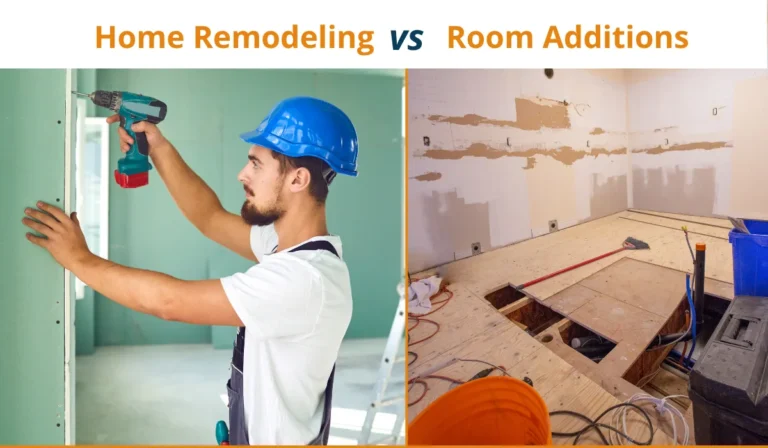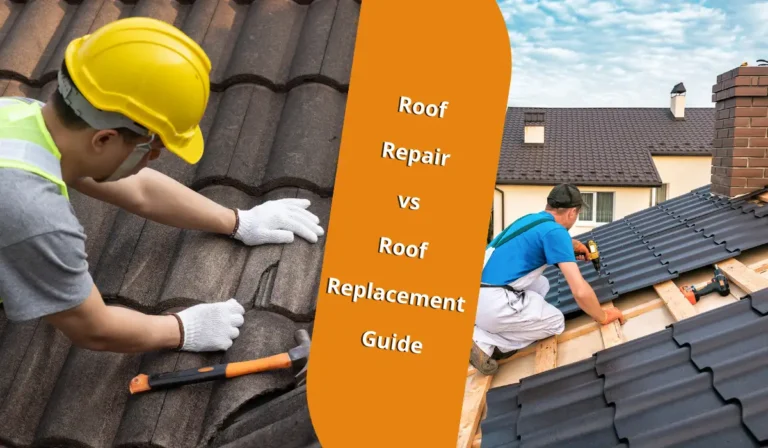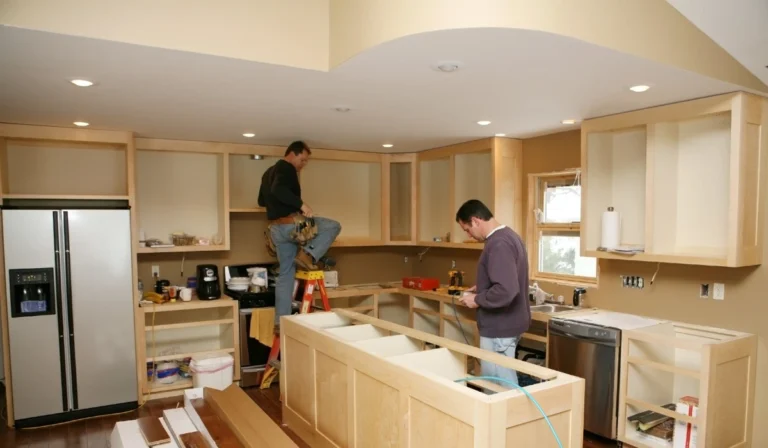Protecting your home and family from Texas weather starts with the roof system. In Dallas, Fort Worth, and surrounding areas, homeowners often face the critical choice between roof repair and roof replacement. Making the right decision safeguards your structural integrity and long-term investment.
Roof repair costs typically range from $150 to $8,000, while a full replacement can run $15,000 to $28,000, depending on materials, labor, and roof complexity. Beyond cost, factors like roof age, damage extent, and hidden structural issues, including decking or rafter concerns, play a major role in determining whether a repair will suffice or a replacement is the wiser choice.
Understanding the financial, insurance, and energy implications is equally important. Repairs may be quick and cost-effective for minor damage, but a full replacement often enhances home value, curb appeal, and energy efficiency, while qualifying for insurance coverage under RCV (Replacement Cost Value) policies and maintaining manufacturer and workmanship warranties.
This guide equips Dallas/Fort Worth homeowners with expert insights on when to repair, when to replace, and how to maximize both structural integrity and long-term ROI (Return on Investment), ensuring decisions are based on facts, not guesswork.
Key Takeaways
- Repair is ideal for minor, localized damage on roofs under 10 years old, providing a quick and cost-effective solution.
- Replacement is necessary for aging roofs (15-20+ years), extensive or recurring damage, structural issues, or visible signs of mold, sagging, or granule loss.
- Total Cost of Ownership (TCO) matters: Repeated repairs can exceed the cost of a single replacement over 20 years.
- Home value and ROI increase with a new roof, improving curb appeal, energy efficiency, and resale potential.
When to Repair vs. When to Replace (Based on DFW Home Structures)
Roof Repair:
- Best for minor, localized damage (e.g., a few missing shingles or a small leak).
- Roof age under 10 years.
- Less expensive upfront: $150-$8,000.
- Short-term solution; repeated repairs can add up over time.
Roof Replacement:
- Best for extensive damage, aging roofs, or recurring issues.
- Roof age 15-20 years or older.
- Long-term investment: $15,000-$28,000.
- Improves energy efficiency, curb appeal, and resale value.
Repair minor leaks immediately to prevent decking or rafter damage.
Deciding whether to repair or replace a roof in Dallas, Fort Worth, and surrounding Texas areas requires a careful evaluation of both visible and hidden damage.
While the cost difference between a repair ($150-$8,000) and a full replacement ($15,000-$28,000) may tempt homeowners toward a quick fix, a strategic decision depends on Age, Damage Extent, and the Structural Integrity of the roof system.
1. Repair Criteria and Limitations
Repair is appropriate when:
- Damage is localized (e.g., a small leak or a few missing shingles).
- The roof is under 10 years old.
- No signs of structural compromise (decking, rafters, or underlayment intact).
Challenges to consider:
- Shingle Color Matching: Older roofs may have inconsistent aesthetic appeal after repairs.
- Cost Variables: Emergency fees, steep pitch surcharges, and partial decking replacement can increase repair costs.
Small, timely repairs extend your roof’s lifespan and prevent major structural damage.
Roof repair is typically most effective when damage is localized, such as a small area of shingle loss or minor storm impact, and the roof is relatively young; generally less than 10 years old.
In these scenarios, a professional roofing contractor can restore protection efficiently without replacing the entire system.
However, repairs come with aesthetic and structural limitations. Older roofs present the shingle color matching challenge, where new shingles may stand out against weathered surfaces, impacting curb appeal and aesthetic consistency.
Even if the repair is structurally sound, homeowners may notice mismatched shingles, which can subtly reduce resale value and overall marketability.
Repair costs also vary significantly depending on roof complexity. Factors like emergency service fees, steep or irregular roof pitches, and the need for partial decking replacement drive the final cost.
For example, an urgent repair after a hailstorm in Dallas could double typical labor rates, while replacing damaged decking increases materials and labor expenses.
By understanding these variables, homeowners can gauge whether a repair is a short-term fix or a step toward a larger replacement.
2. Definitive Replacement Triggers: When Is Replacement the Right Choice?
Replacement triggers include:
- Roof age approaching or exceeding 15-20 years.
- Structural failure signs: sagging roofline, widespread granule loss (>25% of surface), or evidence of poor original installation.
- Severe damage: visible mold, mildew, or water stains indicating structural leakage.
Replace your roof if it is 15-20 years old or shows sagging, mold, or widespread granule loss.
While repairs may suffice for minor issues, certain conditions make full replacement the safer, smarter option. Roofs approaching 15-20 years of age are prone to widespread material fatigue, making replacement a practical investment.
Visible signs of structural failure provide clear cues. A sagging roofline, extensive granule loss (over 25% of the surface), or evidence of poor original installation indicates the roof system can no longer maintain its structural integrity.
Waiting to repair under these conditions can accelerate damage to the underlying decking, rafters, and even attic insulation, ultimately increasing long-term costs.
Severe roof damage, such as mold, mildew, or pronounced water stains, signals that repairs may not suffice.
Mold growth often spreads beneath shingles and underlayment, compromising both the roof and indoor air quality; a particular concern during humid Texas summers.
Addressing these problems typically requires the removal of the affected roof sections, making replacement a more cost-effective and comprehensive solution.
3. The “Hidden Damage” Hierarchy
- Damage progresses from shingle loss → underlayment exposure → deck rot → rafter/truss damage.
- Surface-level repairs may mask deeper structural integrity issues, making early professional inspection critical.
A full replacement is more cost-effective than repeated repairs after two or more significant roof issues.
One of the most important concepts for homeowners is understanding hidden damage progression. Surface-level issues rarely exist in isolation: shingle loss can lead to underlayment exposure, which eventually causes deck rot.
Left unaddressed, this can compromise rafters or trusses, putting the roof’s structural integrity at serious risk.
Professional roof inspections in the DFW area often reveal hidden water intrusion, sub-roof deterioration, or poor flashing installation that homeowners might overlook.
Recognizing these warning signs early can prevent costly emergency repairs and maximize the lifespan of the roof system.
A licensed and insured roofing contractor, ideally with RCAT-Certification, can identify these issues, provide a documented assessment for insurance purposes, and advise whether repair or replacement delivers the best long-term value (TCO).
Don’t wait for minor damage to worsen. Contact us to hire a licensed Dallas roofing contractor for a thorough assessment.
How Much Will Roof Repair vs. Replacement Really Cost Over Time? (TCO, ROI, and Energy)
When Dallas/Fort Worth homeowners weigh roof repair versus replacement, understanding the financial implications is as critical as evaluating structural integrity.
A roof is more than a protective covering; it is a long-term investment affecting your home value, energy efficiency, and overall Total Cost of Ownership (TCO).
1. Total Cost of Ownership (TCO) Analysis
The TCO framework considers both immediate expenses and long-term costs associated with repeated repairs versus a single roof replacement.
Frequent patch repairs for minor leaks or shingle damage may seem budget-friendly initially, but over 10-20 years, these recurring expenses often surpass the cost of a full replacement.
For example, a Dallas homeowner who invests $1,000-$2,500 per repair every few years may spend $15,000-$20,000 cumulatively, equaling or exceeding the cost of a new roof system.
By contrast, a replacement provides a fresh, durable system with modern underlayment, decking, and shingles, reducing the likelihood of hidden issues like deck rot, underlayment exposure, or truss damage.
This approach not only safeguards structural integrity but also minimizes emergency costs and insurance complications.
2. Home Value, ROI, and Curb Appeal
Beyond repair costs, a new roof is a tangible investment that enhances curb appeal and marketability.
Note that A new roof can significantly boost your home’s value, typically yielding an average return on investment (ROI) between 60% and 85%, influenced by material quality, energy efficiency, and local market appeal.
A well-maintained, visually appealing roof reassures potential buyers and accelerates property sales, especially in competitive Dallas neighborhoods.
Repairs, while functional, often leave visible shingle mismatches or minor imperfections that subtly decrease perceived home value.
A full replacement ensures both structural and aesthetic excellence, making it a strategic financial choice for homeowners planning to sell within the next decade.
3. Energy Savings: The ‘Cool Roof’ Factor
Another critical financial consideration is energy efficiency. Texas summers are notorious for soaring temperatures, placing significant strain on HVAC systems.
A new roof with modern Cool Roof Technology can dramatically reduce energy consumption, lowering utility bills while improving indoor comfort.
Key components of energy-efficient roofing include:
- Solar Reflectance Index (SRI): Higher SRI ratings reflect more sunlight, reducing heat absorption.
- Cool Roof Materials: Options like reflective asphalt shingles, metal roofing, or tile help maintain lower attic temperatures.
- Attic Ventilation: Proper airflow prevents heat buildup and extends shingle lifespan.
A Dallas homeowner investing in a reflective roof with adequate ventilation may see 10-15% lower cooling costs annually, which compounds over a 20-year period, effectively offsetting part of the upfront replacement cost.
4. Material Comparative Table
Here’s a quick comparison of the top three roofing materials, showing lifespan, energy efficiency (SRI), and average replacement cost for Dallas homes.
| Material Type | Lifespan (Years) | SRI Score | Average Cost (DFW) |
| Asphalt Shingles | 20-30 | 0.25-0.35 | $15,000-$18,000 |
| Metal Roofing | 40-60 | 0.50-0.70 | $20,000-$28,000 |
| Tile (Clay/Cement) | 50-75 | 0.45-0.60 | $25,000-$28,000 |
Choose a roofing material based on lifespan, energy efficiency, and budget to maximize long-term value and savings.
This comparison helps homeowners select a roofing system that balances lifespan, energy efficiency, and upfront cost, while maximizing both Total Cost of Ownership (TCO) and long-term Return on Investment (ROI).
Compare roofing materials with a certified contractor to see which option maximizes energy savings and long-term ROI for your home
Financial Takeaways for Dallas Homeowners
- Repeated repairs often exceed the TCO of a strategic replacement over 10-20 years.
- A new roof enhances home value, curb appeal, and resale potential; it is critical for homeowners in the competitive DFW market.
- Energy-efficient roof materials and proper attic ventilation contribute to measurable utility savings, reducing overall ownership costs.
By combining structural analysis from Part A with these financial insights, homeowners can confidently assess when investing in a replacement outweighs the short-term appeal of repair, ensuring the home remains secure, energy-efficient, and financially optimized.
How Does Insurance Affect Your Roof Repair or Replacement Decision?
For Dallas and Fort Worth homeowners, insurance considerations often tip the scale between roof repair and replacement.
Navigating the complexities of Replacement Cost Value (RCV) versus Actual Cash Value (ACV) policies, understanding insurer preferences, and avoiding common pitfalls are essential to secure financial coverage.
1. RCV vs. ACV: The Financial Decider
Your insurance policy determines how much coverage is available for roof damage. Replacement Cost Value (RCV) covers the full cost to repair or replace a roof without factoring in depreciation, whereas Actual Cash Value (ACV) deducts depreciation from the payout, often leaving homeowners responsible for significant out-of-pocket expenses.
For example, a Dallas homeowner with a 15-year-old asphalt roof may face a replacement cost of $18,000.
Under an ACV policy, depreciation could reduce the payout by 40-50%, meaning the homeowner may pay $7,000-$9,000 themselves.
With RCV, the same claim could cover the full replacement, emphasizing why understanding your coverage is critical before deciding between repair and replacement.
Ensure your insurance claim covers the right solution. Schedule an inspection before minor damage becomes a denied claim.
2. Replacement Scenarios Insurers Prefer
Insurers often favor full replacement claims when multiple factors coincide:
- Storm Damage Combined with Age: Hail, wind, or storm-related damage on an aging roof increases the likelihood of full replacement approval.
- Code Compliance Triggers: If local building codes or ordinances require upgrades, such as updated underlayment or decking, the insurer may approve a complete system replacement to meet compliance.
Being proactive and documenting roof damage after storms in DFW ensures homeowners maximize insurance benefits while maintaining structural integrity.
3. Avoiding Insurance Pitfalls
Several common mistakes can jeopardize a claim or lead to higher costs:
- Delaying Inspections: Waiting to inspect a damaged roof can trigger the Neglect Clause, resulting in partial or denied claims.
- Hiring the Cheapest Roofer: Contractors lacking proper licensing, insurance, or documentation may fail to provide evidence insurers require for approval, increasing homeowner liability.
Engaging a licensed, insured, and RCAT-certified contractor in Texas ensures compliance, protects warranty coverage, and strengthens insurance claims, preventing costly disputes or denied payouts.
4. Reduce Worry About Any Damage
Beyond dollars and cents, the non-financial benefits of a proper roof replacement are substantial.
A new, professionally installed roof with a Manufacturer’s Material Warranty and Contractor Workmanship Warranty reduces worry about future water damage, mold, mildew, or pest intrusion.
Knowing that both the roof system and the installer are insured allows homeowners to sleep easily, confident that their home remains protected against DFW storms, high summer temperatures, and long-term wear.
By factoring in insurance coverage alongside structural and financial considerations, homeowners make informed decisions that balance cost, risk, and long-term value, ensuring that repair or replacement is not just a short-term fix but a strategic investment.
How Can Dallas Homeowners Safely Inspect Their Roof and Choose the Right Contractor?
Ensuring a safe and effective roof repair or replacement requires more than assessing damage; it demands authority, professional vetting, and adherence to safety protocols.
For Dallas/Fort Worth homeowners, leveraging checklists empowers informed decisions while mitigating risk.
1. The Homeowner’s Self-Inspection & Attic Access Checklist
A preliminary inspection helps identify visible and hidden signs of roof damage before calling a contractor:
- Exterior Signs: Missing or curled shingles, widespread granule loss, algae or moss growth, sagging rooflines.
- Interior Signs: Light penetration in the attic, wet insulation, water stains on rafters, and mold or mildew growth.
Documenting these observations supports insurance claims and guides professionals toward accurate repair or replacement recommendations.
Work with an RCAT-certified, fully insured contractor to protect your investment.
2. DIY Risk Assessment
While DIY roof repairs may seem cost-effective, the risks often outweigh the potential savings. Understanding these dangers is part of the Unique Value Proposition (UVP) of hiring professional contractors:
- Falls and Injuries: Roof heights and steep pitches in Dallas homes increase the risk of serious falls.
- Electrical Hazards: Roofs may contain wiring for vents, solar panels, or other equipment.
- Voiding Warranties: Unauthorized repairs can invalidate Manufacturer’s Material or Contractor Workmanship Warranties.
Recognizing these hazards reinforces the importance of hiring licensed and insured roofing professionals, ensuring both safety and warranty protection.
3. Vetting Your Contractor: The ‘Insurance-Ready’ Authority Checklist (Unique Value Proposition)
A thorough contractor vetting process ensures quality work, insurance compliance, and durability. This section represents a UVP by providing actionable guidance homeowners can rely on:
- Foundational Trust: Confirm the contractor is honest, licensed, insured, and provides verifiable references.
- Advanced Vetting: Ensure they are RCAT-certified, meet minimum liability insurance limits, and provide Lien Waivers for completed work.
- Documentation: Contractors should supply inspection reports, permits, and photos to support insurance claims.
Following this checklist protects both your home and your financial investment.
4. The Reference Check Protocol
Checking contractor references is another UVP of hiring experienced professionals. Asking the right questions helps confirm reliability and workmanship:
- Was the project completed on time and within budget?
- How were additional damages or change orders handled?
- Were there any post-installation issues, and how were they resolved?
These questions provide insights into the contractor’s reliability and professionalism, helping homeowners make confident decisions.
5. Warranty Breakdown
Understanding warranty coverage prevents future disputes:
- Manufacturer’s Material Warranty: Covers defects or premature material failure.
- Contractor’s Workmanship Warranty: Protects against installation errors, typically prorated or non-prorated depending on terms.
Combining self-inspection, risk assessment, contractor vetting, and warranty understanding ensures homeowners make informed, low-risk decisions, protecting both their investment and structural integrity.
Conclusion: Your Expert-Backed DFW Decision
Choosing between roof repair and replacement is one of the most significant decisions for Dallas/Fort Worth homeowners, impacting structural integrity, financial investment, and long-term protection. Repairs may suffice for localized issues on roofs under 10 years old, but widespread damage, aging materials, or hidden structural deterioration often necessitate a full roof replacement to protect your home and family.
A new roof enhances curb appeal, resale value, and energy efficiency, especially when combined with Cool Roof Technology, proper attic ventilation, and high SRI-rated materials. In addition, understanding your insurance, whether RCV or ACV, and hiring licensed, insured, RCAT-certified contractors ensures claims are properly handled and warranties remain valid.
To make an informed, confident choice, schedule a Comprehensive 10-Point Roof Inspection with us today. This inspection evaluates visible and hidden damage, verifies structural and system integrity, and provides a clear recommendation on repair or replacement. Don’t leave your DFW home vulnerable; act now to protect your investment, maximize value, and secure lasting peace under your safe roof.
FAQs
How Often Will Hail or Wind Storms Void My Roof’s Warranty in Texas?
Manufacturer warranties usually become void only if the damage is clearly determined to be from improper installation, not severe weather, as storm damage is typically covered by your separate homeowner’s insurance policy.
Should I Get Three Estimates for a Roof Replacement, or Is That Overkill?
Getting three detailed estimates is necessary to establish an accurate market price for DFW and to compare the scope of work, warranty coverage, and the contractor’s professionalism.
What Specific Building Codes in DFW Might Force Me to Get a Full Roof Replacement?
Local DFW/Texas building codes often mandate a full replacement if a repair requires the removal of more than 25% of the roofing system, or if the system uses materials that no longer meet current wind and fire ratings.
If I’m Only Staying in My Home for 3-5 More Years, Does Repair Still Make Sense?
Repair makes financial sense for a short timeline of 3-5 years only if the existing roof is under 15 years old and the total repair cost is less than 30% of the full replacement cost.
Does a New Roof Qualify Me for Any Home Insurance Discounts in Texas?
Yes, a new roof, especially one installed with impact-resistant Class 4 shingles and compliant with newer wind mitigation standards, can often qualify you for a premium discount with many Texas insurance carriers.






